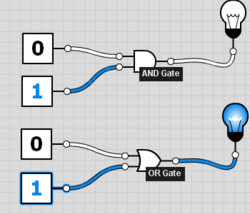Logic gate (nonfiction): Difference between revisions
Jump to navigation
Jump to search
No edit summary |
No edit summary |
||
| Line 16: | Line 16: | ||
File:Toffoli gate.svg.png|link=Toffoli gate (nonfiction)|Circuit representation of [[Toffoli gate (nonfiction)|Toffoli gate]]. | File:Toffoli gate.svg.png|link=Toffoli gate (nonfiction)|Circuit representation of [[Toffoli gate (nonfiction)|Toffoli gate]]. | ||
File:LogicGates.jpg|Logic gate chart. | File:LogicGates.jpg|Logic gate chart. | ||
File:Aristotle - Roman copy after Greek bronze by Lysippos.jpg|link=Logic (nonfiction)|[[Logic (nonfiction)|Aristotle]] eager to see the new logic gates. | |||
</gallery> | </gallery> | ||
Revision as of 16:45, 23 June 2016
In electronics, a logic gate is an idealized or physical device implementing a Boolean function.
That is, it performs a logical operation on one or more logical inputs, and produces a single logical output.
All of the principles of Boolean logic can be expressed as logic gates.
With amplification, logic gates can be cascaded in the same way that Boolean functions can be composed, allowing the construction of a physical model of Boolean logic.
In principle, any algorithm can be expressed as logic gates.
In reversible logic, Toffoli gates are used.
In the News
Circuit representation of Toffoli gate.
Aristotle eager to see the new logic gates.
Fiction cross-reference
Nonfiction cross-reference
External links:
- Logic gate @ wiki.karljones.com
- Logic gate @ Wikipedia



